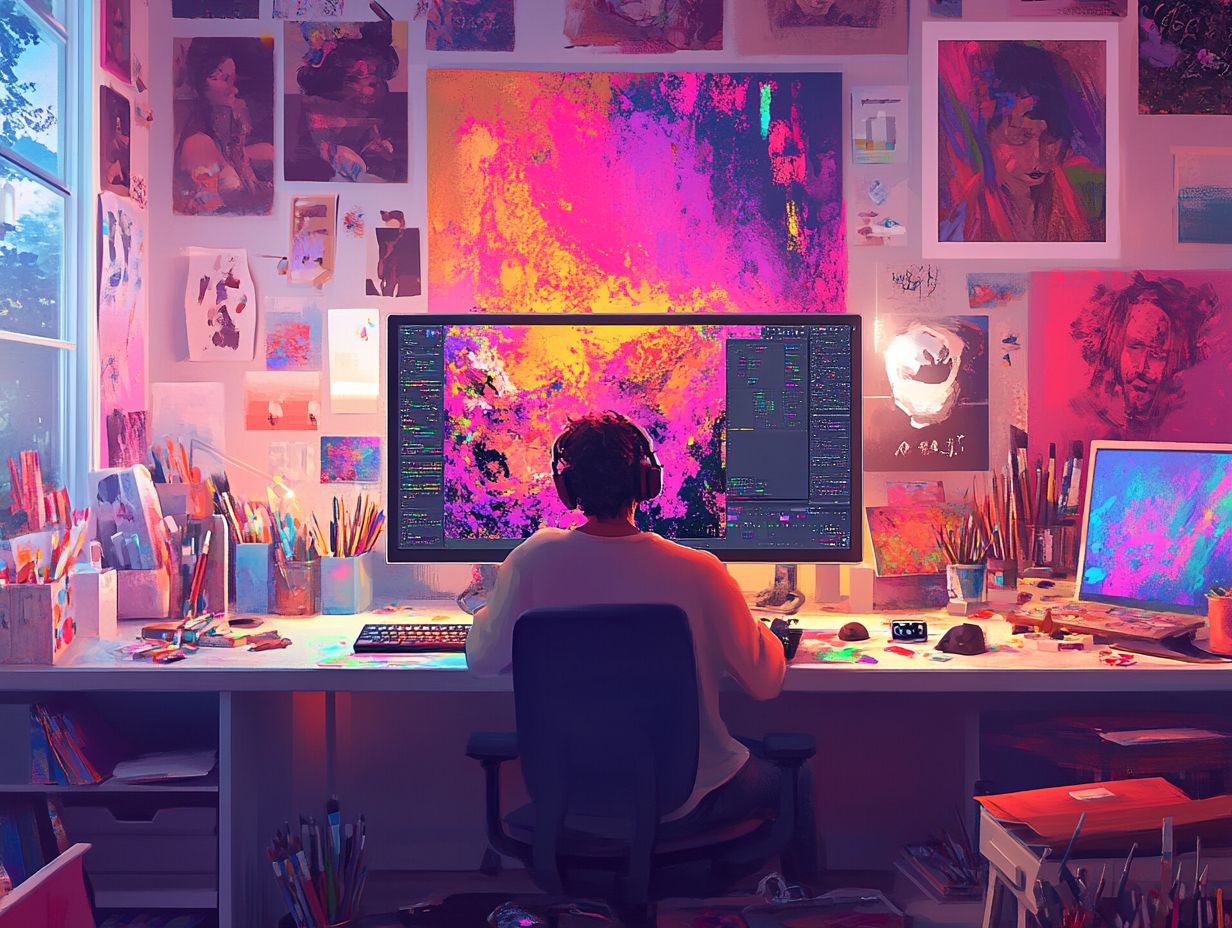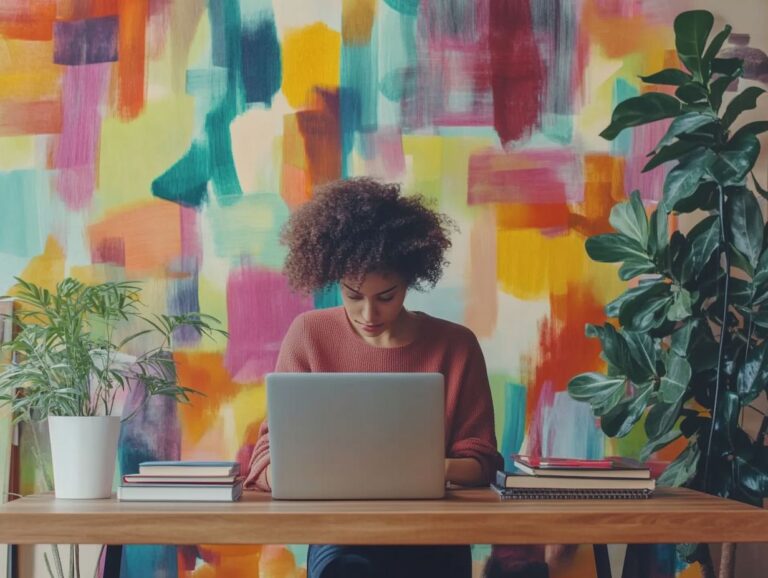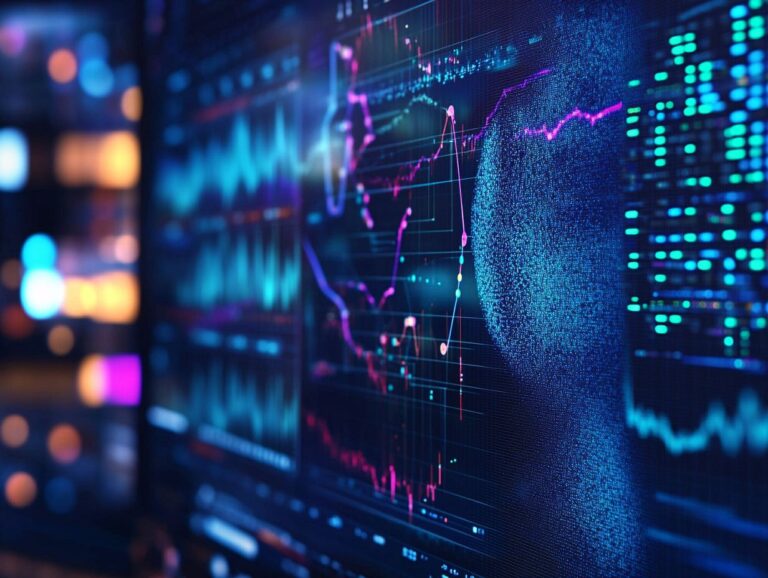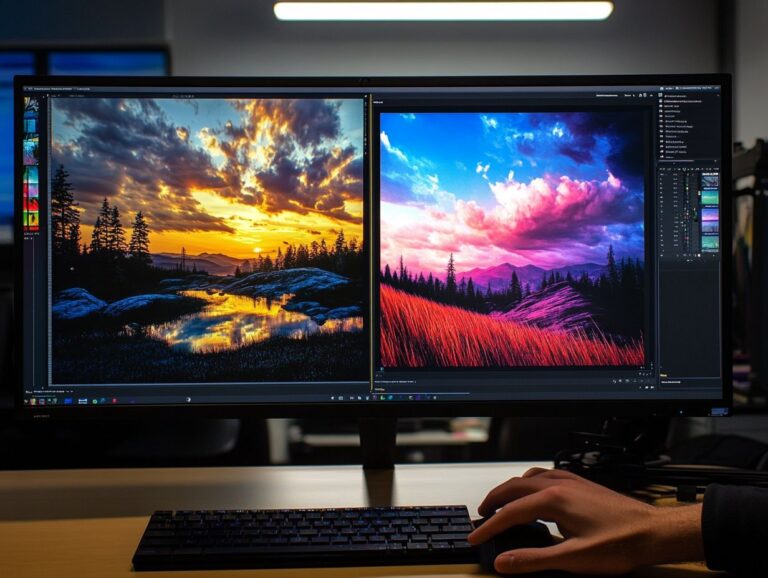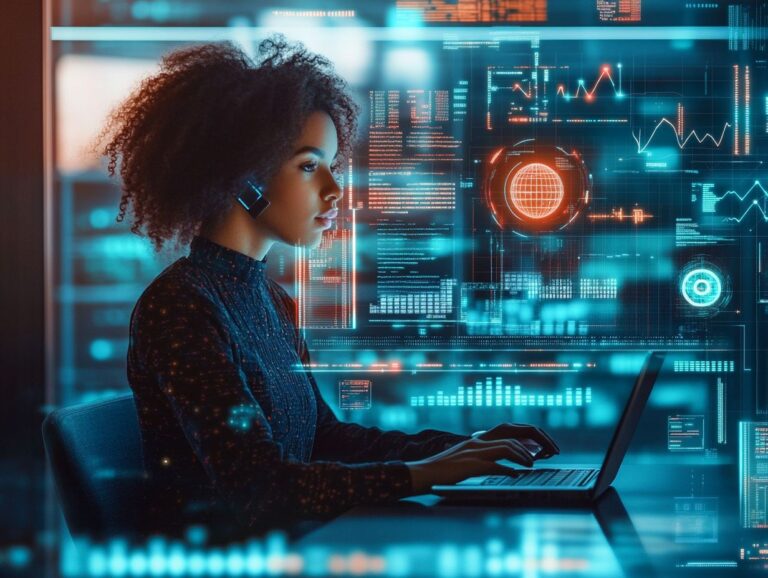How to Create Art Using AI?
AI art refers to artwork created using artificial intelligence and machine learning tools. This medium encompasses a wide range of forms, including music, graphic design, still photography, 3D modeling, and video. AI art can be produced with the assistance of AI, generated solely by AI, or created through a combination of both.
Here is a comprehensive overview of AI art, covering the following topics:
- What is AI art?
- Types of AI art
- How is AI art created?
- Benefits and limitations of AI art
- Ethics and societal impacts of AI art
- Tips for creating AI art
- Where to find and showcase AI art
- How to learn about AI art and discover helpful tools
Contents
Key Takeaways:
What Is AI Art?
AI art refers to artworks created using artificial intelligence technology or machine learning algorithms. This medium has gained popularity and sparked controversy, as it offers new avenues for artistic expression while simultaneously challenging conventional notions of creativity, authorship, and copyright.
AI art is being utilized across various domains, including traditional painting, music, video games, and fashion. These emerging forms of AI art raise important questions about whether machines can truly create art that resonates emotionally and the implications of integrating machine-generated outputs into traditional artistic environments.
What Are The Different Types Of AI Art?
AI art encompasses a diverse range of artistic styles and outputs, all made possible by various AI art generators and tools that employ generative AI techniques to produce unique works of art. This diversity illustrates the adaptability of AI applications in artistic creation and highlights the limitless potential for creative expression.
One such tool, NightCafe, generates stunning images in styles like cubism and surrealism while allowing users to merge multiple styles. Another tool, Artbreeder, enables users to combine and evolve images using genetic algorithms, resulting in entirely new visual representations.
Additionally, the Deep Dream Generator employs neural networks to create dream-like images that often inspire reflection and contemplation. Collectively, these AI art tools redefine traditional notions of art and open up new avenues for exploring imagination and creativity beyond what individuals might achieve on their own.
How Is AI Art Created?
AI art is created using various methods that take input text and prompts to transform them into artistic images through different AI generation techniques. These techniques include generative adversarial networks (GANs), Stable Diffusion, and DALL-E, which utilize complex algorithms to interpret and visualize artistic concepts.
As a result, users can produce AI-generated artwork with a high degree of accuracy and creativity.
1. Training The AI Model
Training the AI model is a crucial step in generating AI art, as it involves teaching machine learning algorithms to understand and interpret various artistic concepts and styles. This training phase requires a massive dataset of existing artworks and clear, specific prompts designed to guide the model in creating meaningful artistic outputs.
These datasets often encompass numerous genres, time periods, and techniques, providing a rich foundation from which the AI can learn. Techniques such as supervised learning, where the model is taught to recognize patterns and styles through labeled examples, are essential for refining its capabilities.
The intricate relationship between artistic creation and the knowledge embedded in these datasets fosters a deeper understanding within the AI, ultimately enhancing the quality and relevance of its artistic outputs. As artists experiment with the boundaries of traditional forms, they inadvertently contribute to the evolving landscape of AI training, ensuring that the model remains attuned to contemporary styles and trends.
2. Generating Images With The Trained Model
After training, the AI model is capable of generating images based on input text and artistic prompts that contain clear, descriptive elements related to the desired artwork. At this stage, users have the opportunity to express their creativity by crafting high-quality AI prompts that enable the production of unique and intriguing AI-generated artworks.
The transition from a few words of text to a completed work of art is highly dependent on the parameters provided by the user. Every word is significant, as the model interprets style, colors, and layout based on the chosen words. This means that the more thoughtful and creative the prompts, the better the AI can utilize its algorithms to render an appealing image.
In essence, the creativity of the AI is largely shaped by human input, which directs the rendering process and engages with the human creative experience, ultimately merging human and machine artistry.
3. Refining And Editing The Generated Images
Refining and editing generated images is a crucial step that enables artists to enhance the final output and bring it closer to their artistic vision. By using various online image editors and art tools, creators can manipulate different elements of their artwork, improving its visual aesthetic and ensuring it aligns with their intended interpretation.
Tools like Adobe Photoshop or GIMP offer extensive features, including layers, filters, and adjustments, allowing for greater control over the editing process. Additionally, artists may prefer platforms such as Canva or Procreate for their intuitive interfaces, which facilitate quick modifications.
Techniques such as color correction, cropping, and texture addition give the power to artists to infuse their unique style and flair into AI-generated images. By leveraging these resources, artists can reinterpret AI outputs in innovative ways, transforming basic AI creations into distinctive pieces of art that showcase their individual creativity while harnessing the benefits of machine-generated inspiration.
What Are The Benefits Of AI Art?

AI art offers several benefits that are transforming the landscape of artistic expression, including speed and efficiency, limitless creativity, and enhanced accessibility and inclusivity.
- Speed and Efficiency: AI art allows artists to produce intricate works in a fraction of the time it would take using traditional techniques.
- Limitless Creativity: AI provides artists with the opportunity to push boundaries and explore new artistic territories in ways that were previously unimaginable.
- Accessibility and Inclusivity: AI art fosters greater accessibility and inclusivity within the art community, making it easier for individuals from diverse backgrounds to engage with and contribute to the world of art.
1. Speed And Efficiency
One of the most significant advantages of AI art is its speed and efficiency, enabling artists to produce highly detailed and complex works in much less time than traditional methods of artistic creation.
The technological advancements facilitate faster experimentation and iteration, allowing artists to refine their ideas more effectively. For instance, digital painters can leverage AI algorithms to generate backgrounds or patterns, saving them hours of tedious work and allowing them to focus more on the creative aspects of their projects.
A graphic designer, for example, utilized AI tools to create concept art for a video game, producing multiple character design iterations within hours a process that would typically take weeks.
These tools not only accelerate the creative process but also enhance creativity, giving artists the opportunity to explore styles and concepts that would normally require a significant time investment.
2. Limitless Creativity
AI art acts as a catalyst for limitless creativity, allowing artists to explore uncharted territories of artistic expression while challenging conventional boundaries. By leveraging generative AI, creators gain the freedom to experiment with diverse styles, ideas, and concepts that may not have been achievable through traditional methods.
These advancements have led to remarkable projects such as Refik Anadol’s installations, which creatively merge architectural spaces with data-driven visuals, transforming environments into immersive experiences. Tools like DALL-E and Midjourney give the power to artists to transform their textual prompts into stunning visual artwork, bridging the gap between imagination and realization.
This fusion of technology and art not only enhances the creative toolkit available to artists but also encourages collaboration across disciplines, ultimately reshaping how art is perceived and enjoyed in the modern age. As these innovative solutions continue to evolve, they inspire a new generation of creators to redefine the future of artistic expression.
3. Accessibility And Inclusivity
One of the main advantages of AI art is its accessibility and inclusivity, enabling a broader demographic to engage in creative expression regardless of their technical skills or backgrounds. AI art tools democratize the artistic process, allowing anyone to create beautiful works of art with relative ease.
Platforms like DeepArt and Artbreeder offer user-friendly interfaces that give the power to users to express their creativity without requiring traditional artistic training. Additionally, AI Art Gallery promotes diverse participation by showcasing the works of underrepresented artists, ensuring a wide range of voices in the digital art landscape. If you’re interested in exploring further, check out this guide on how to create video using AI.
These tools not only create a welcoming environment for beginners but also foster collaboration between established artists and aspiring creators, ultimately enriching the creative community and expanding the possibilities of artistic expression.
What Are The Limitations Of AI Art?
AI art has notable disadvantages that can impact its overall effectiveness and desirability. One of the primary drawbacks is the absence of emotional connection in AI-generated pieces. These artworks often struggle to convey the depth of human experience and artistic expression, leading to outputs that can sometimes appear bland and repetitive.
1. Lack Of Emotional Connection
Emotional disconnection represents one of the most significant limitations of AI art, as many viewers find it challenging to connect with works created entirely by algorithms, which lack the depth of human experiences. This disconnect raises concerns about the authenticity and emotional resonance of AI-generated artworks.
Increased skepticism can profoundly impact audience reception, often causing people to overlook the ingenuity of the technology behind it. For instance, an exhibition of AI art at a prestigious gallery received only a lukewarm response from visitors, who cited a lack of emotional connection as the primary reason for their tepid reaction.
In contrast, artists like Frida Kahlo and Vincent van Gogh continue to resonate with audiences through their deeply emotional narratives, inspiring visceral responses that highlight the importance of emotional connection in how art is received and valued.
The broader art community grapples with these implications, recognizing that expanding the boundaries of creativity with AI will necessitate finding ways to incorporate human emotion into artificial creations.
2. Repetitive And Unoriginal Results
One limitation of AI-generated art is the potential for repetitive and unoriginal output. Generative algorithms often rely on existing data and patterns, which can result in artworks that lack uniqueness and freshness. This can diminish the impact of AI art and raise questions about the originality of its creative outputs.
When algorithms are heavily influenced by a particular style or technique from the past, they tend to produce derivative work rather than innovative creations. Such dependence on historical data can lead to a sense of staleness, where viewers encounter the same themes and motifs repeatedly. Consequently, the quality of the output suffers, making it imperative for both developers and artists to devise solutions that prioritize creativity and exploration.
Emphasizing new ideas is essential not only for the advancement of digital art but also for the ongoing discussion about what constitutes valuable art in an era dominated by technology and machine learning.
What Are The Ethical Implications Of AI Art?
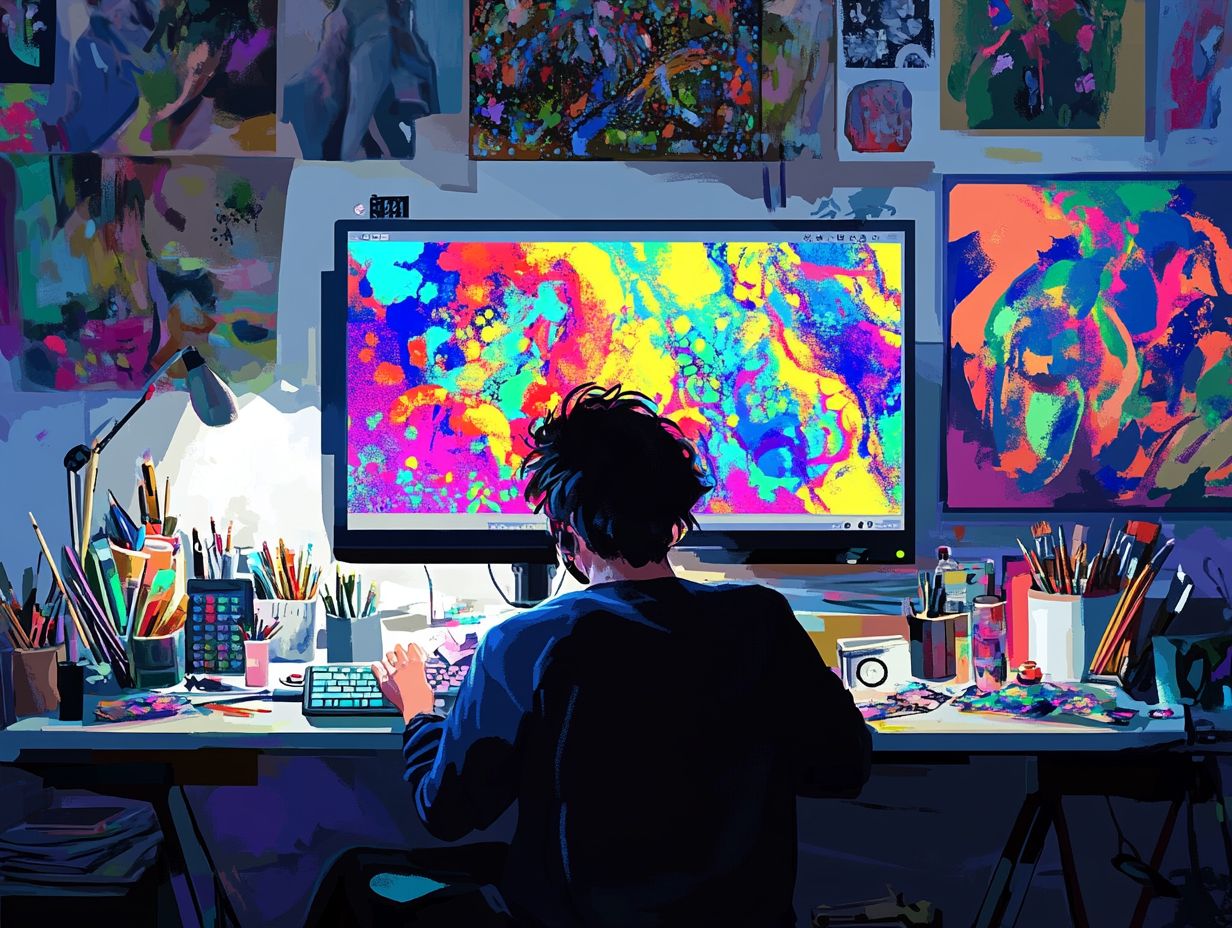
The emergence of AI art presents several ethical implications that require careful management, particularly regarding the ownership and authorship of AI-generated tools and products.
Disputes over the rights to AI art frequently lead to intricate discussions about copyright issues, biases inherent in AI algorithms, and concerns related to discrimination.
1. Ownership And Authorship
The question of ownership and authorship is one of the most significant ethical implications of AI-generated art. The issue of who deserves credit for an artwork created by algorithms complicates traditional notions of artistic authorship.
This dilemma raises serious copyright concerns that affect artists, developers, and the broader creative community. As AI systems increasingly produce artworks that reflect human creativity, the legal protections for original works become more problematic.
Many individuals within the industry find themselves confused by legal frameworks that are often ambiguous and typically require human authorship for protection. This vagueness can lead to disputes over who owns the rights to the final product whether it is the programmer, the user who defined the parameters, or the AI tool itself.
As courts and legislators work to address these issues, discussions around potential solutions, such as creating a new category of copyright for AI art or establishing joint authorship rights, are essential. By raising accountability through these discussions, we also promote the need for innovation in both the artistic and technological realms.
2. Bias And Discrimination
Bias and discrimination are significant ethical concerns in the realm of AI art, as algorithms can inadvertently perpetuate existing stereotypes and inequalities in artistic creation. It is essential to address these biases to ensure that AI-generated artworks promote inclusivity and diversity within the art world.
When AI systems are trained on datasets that lack representation or are skewed towards dominant cultural narratives, the resulting artwork often reflects these limitations. This not only excludes voices from marginalized communities but also reinforces harmful stereotypes, thus undermining the potential of AI as a tool for creative expression.
To overcome these challenges, developers and artists must prioritize the use of diverse datasets that accurately capture the richness of various cultures. Additionally, implementing rigorous testing and feedback loops can help identify and rectify biases in AI outputs, leading to a more equitable and authentic representation of the myriad identities that enrich our society.
How Can Someone Get Started With Creating AI Art?
Creating AI art requires learning about various AI tools and platforms, as well as engaging in experimentation and practice to develop skills in this innovative medium.
Artists can leverage AI technologies to enhance their creative processes and collaborate with others in the field to explore the limitless possibilities of artistic creation.
1. Familiarize Yourself With AI And Art Tools
Familiarizing yourself with various AI and art tools is an essential first step in successfully creating AI art, as it opens the door to numerous online platforms and AI art generators that streamline the artistic process. Understanding the functionalities of these tools will enable you to leverage their capabilities effectively.
Among these platforms, NightCafe Creator stands out due to its user-friendly interface and impressive variety of styles, ranging from dreamy landscapes to intricate abstract designs. This tool allows users to experiment with neural style transfer and various algorithms, making it accessible for both beginners and experienced artists seeking to explore new techniques.
Picsart enhances the creative journey with its robust editing features, facilitating the seamless integration of AI-generated art with traditional design elements. Both tools offer tutorials and resources, ensuring that newcomers can feel confident in their ability to produce stunning pieces, ultimately bridging the gap between technology and imagination.
2. Experiment And Practice With Different Techniques
Experimenting with and practicing different techniques is essential for creating AI art, as exploring various styles and methods can lead to diverse creative outcomes. Adopting a trial-and-error mindset enhances the overall artistic process.
This exploration of AI art opens up new opportunities to practice and develop new skills and visual languages. Engaging with different AI models and tools helps maintain creativity and keeps artists connected to emerging trends. For those interested in expanding their creative horizons, learning how to create NFT using AI can be a valuable addition to their skill set.
Sharing insights and techniques on community platforms enables individuals to give and receive feedback, often resulting in significant artistic breakthroughs. Additionally, documenting the progress of one s work helps identify pivotal moments in its evolution and fosters a deeper engagement with the medium of AI technology.
3. Collaborate With Other Artists And Experts
Collaboration with other artists and specialists in the field of AI art enhances both creative expression and technical understanding while providing opportunities for the sharing of knowledge and ideas. This collaborative approach results in richer artistic projects and fosters a supportive community among creators.
By working together, individuals gain access to diverse perspectives and a wealth of knowledge that can expand their artistic vision. Communities on platforms such as Discord, ArtStation, and specialized forums offer vibrant spaces for creators to connect, showcase their work, and seek feedback.
Participating in collaborative challenges or workshops can spark creativity and help build lasting social connections. Communities focused on AI art not only promote the development of technical skills but also cultivate friendships and relationships that may lead to new collaborative projects.
Ultimately, these connections encourage collaboration, enabling creators to collectively push the boundaries of their work.
Frequently Asked Questions
What is AI art?
AI art is a form of art created using artificial intelligence algorithms and software. It involves using computer algorithms to generate or enhance visual or auditory artwork.
What are the benefits of creating art using AI?
Creating art using AI allows for endless possibilities and experimentation, as AI algorithms can generate and manipulate images and sounds in ways that humans cannot. It also allows for collaboration between humans and machines, resulting in unique and innovative artwork.
Do I need to have coding experience to create art using AI?
No, you do not need coding experience to create art using AI. There are various user-friendly AI art software and platforms available that do not require any coding knowledge.
Can I still be considered the artist if I use AI to create my artwork?
Yes, you are still the artist even if you use AI to create your artwork. While AI may assist in the creation process, it is ultimately the human artist who decides the concept and direction of the artwork.
What types of art can be created using AI?
AI can be used to create various types of art, including digital paintings, music, videos, and even sculptures. The possibilities are limitless and constantly evolving as AI technology advances.
How can I start creating art using AI?
To start creating art using AI, you can explore different AI art software and platforms, attend workshops or classes, and experiment with different techniques and styles. It is also helpful to educate yourself on AI technology and its capabilities.


